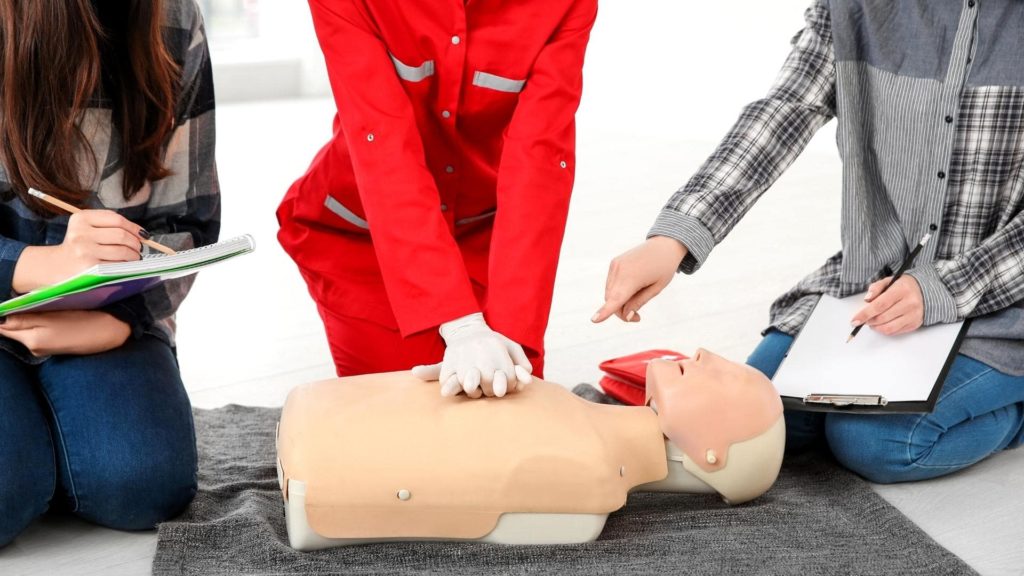First Aid certification offers the training required to save lives. These life saving skills are vital in situations where people are suddenly taken ill or are seriously injured, helping to ensure they are stabilized before professional help arrives.
Difference Between Emergency and Standard First Aid
Emergency First Aid is a comprehensive course designed to cover basic first aid. This course allows trainees to deal with various emergencies and can be completed in one day.
In a Standard First Aid course, the same emergencies are covered in greater depth, but some other skills are also added. Trainees complete the course in 2 days (or 8 hours online and 8 hours in-class for the Online Blended format), and each skill is practiced to ensure it can be carried out with confidence.
Both Emergency and Standard First Aid training certificates are valid for 3 years. When it comes to renewal, Emergency First Aid cannot be recertified; it requires full training again. Standard First Aid can be recertified once, thereafter, candidates alternate between a full and recertification course.
10 Topics Covered in Emergency and Standard First Aid
Both Emergency and Standard First Aid include these 10 topics:
1. Lowering the risk of infection
Here, participants are taught to practice correct hygiene, how to use personal protective equipment (wearing and removing it) to prevent cross infections and the basic rules of wound care.

2. Three Cs of Emergencies
During an emergency, it is often difficult to think clearly. First Aid training is based on the three P’s – preserve life, prevent patient deterioration, and promote recovery. To achieve this, participants are taught the three Cs of an emergency. These are Check (check surroundings for dangers and remove them and complete the ABCs), Call (call EMS or 911 for help), and Care (perform CPR or other necessary care).
Inquire about First Aid Training
3. Recovery position
Recovery care can include everything from moving the patient from harm to bandaging wounds. First aid training teaches participants how to apply the techniques to keep the person warm, dry, stop bleeding, etc. These are the steps that promote quicker recovery. If an ill or injured person is unresponsive, you can put them in the recovery position as long as it is safe to do so. This position protects the person’s airway.

4. Shock
Assessing a situation where the victim has suffered shock is important. In Emergency and Standard First Aid, participants are taught the importance of calling 911, monitoring ABCs and providing care for the cause of shock. They also learn the importance of keeping the person warm and how to keep them comfortable.
5. CPR/AED & Choking (adults, children, and infants)
CPR/AED and Choking training are the most basic and important life saving procedures. First aiders are taught how to manually circulate blood around the body if the heart has stopped beating, how to apply CPR in patients with no pulse or respiration as well as choking interventions for adults, children and infants.

6. Assisting with medications
First aiders cannot dispense medications unless they are assisting someone who has asked for help. Training includes how to assist in preparing medications. Participants also learn how to ensure the right person is taking the right medication (and the correct dose) at the right time correctly.
Register for First Aid & CPR Training
7. Angina and heart attack
Heart disease is one of the leading causes of death in Canada. Learning how to recognize and assist someone having a heart attack is vital to ensuring they receive immediate help to increase chances of survival. They need to be made comfortable, before calling for help. The right steps can save their lives.

8. Stroke
Just like with heart attacks, stroke victims need immediate assistance. First aid training helps participants learn the signs of a stroke and the immediate steps required. A great acronym to remember for stroke is FAST (face, arm, speech, time).
9. Life-threatening internal and external bleeding
External bleeding is more obvious, but first aiders are taught to recognize the signs of internal bleeding too. Managing both these types of bleeding is vital to patient care until help arrives.

10. Wound care
This topic teaches about the different types of wounds and their care. Learn how to bandage, stop a bleed, handle various types of burns and more.
Added Topics for Standard First Aid
Standard First Aid includes an additional five topics, allowing participants to learn how to deal with more emergency issues. These include:
- Head and spinal injuries
- Bone, muscle, and joint injuries
- Medical emergencies
- Environmental emergencies
- Poisons
Should You Get First Aid Certified?
In short, YES! Here you can find 5 reasons why we highly recommend that everyone gets First Aid and CPR certified. You never know when someone will become injured or suffer from a life-threatening disease. By understanding how to provide proper First Aid and CPR, you could save the life of a family member or friend. Get certified today and gain confidence in your life-saving skills.




















No comment yet, add your voice below!